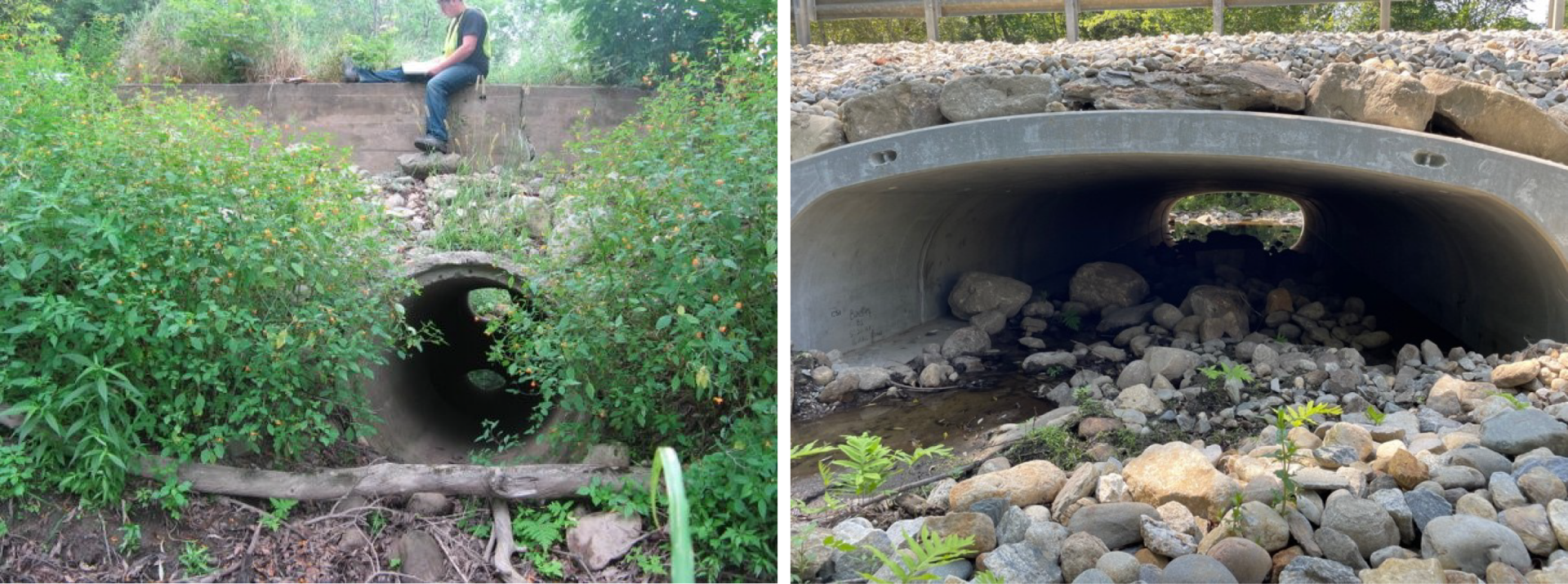While stream crossings may look unassuming, these structures do amazing things. Here in Maine, proper stream crossings help protect stream health, accommodate wildlife, restore habitat for threatened species, improve infrastructure, and prevent structural disasters. Unfortunately, many of our state’s stream crossings have a design life of about 50 years — and in several locations, the buzzer is going off.In this blog, we’ll uncover exactly what this means for municipalities, and how local leaders can protect their communities and ecosystems well into the future. Let’s dive in.
What is a stream crossing and why does it matter?
Wherever a road crosses a stream, it requires either a bridge or a (box/pipe) culvert. A solid stream crossing supports two primary functions:
- Transportation: Since our roads are vital to our state economy (including tourism) as well as our local communities, Maine’s extensive road network needs to remain safe and functional.
- Environmental passage: The thousands of miles of streams flowing through Maine are home to fish, birds, insects, reptiles, mammals, and amphibians. When proper (in terms of sizing, installation, age) stream crossings exist, streams can function naturally, and fish/wildlife can migrate freely.
Currently, many Maine stream crossings are unable to do these jobs – especially those installed around the 1970s, which are starting to fail. Plus, many older stream crossings were designed to protect roads, but not wildlife. These “expired” road stream crossings often exhibit the following common characteristics:
- Undersized diameter (often the round pipe) can restrict natural stream flow and cause issues like scouring and erosion, high flow velocity, clogging, and ponding.
- Shallow depth, which is often not sufficient for organisms to move freely.
- Perched position, which is often the result of improper installation or years of downstream bed erosion. The crossing becomes perched above the stream bottom at the downstream end, preventing wildlife from migrating upstream.
As an example, here’s a “before” (left) and “after” (right) of a new installed stream crossing:

Improper stream crossings = big consequences
Going back to the two primary functions of stream crossings – environmental passage and transportation – here’s the potential impact of non-functioning stream crossings on both:
Environmental passage: According to the Maine Audubon, 85% of wildlife species either live in or use riparian (water-related) habitats throughout the year to breed, travel, and find food and water – making this next stat frightening. According to surveys, up to 90% of Maine culvert crossings make movement difficult or impossible for wildlife for at least part of the year. For example, brook trout, Atlantic salmon, river otters, and other wildlife can get stuck at decaying, undersized stream culverts. And incorrectly sized, poorly placed, or damaged bridges and culverts (especially on smaller streams) can prevent fish and wildlife from accessing food, breeding areas, and other important habitat zones. When a species’ habitat is disrupted and fragmented, it can result in population declines and/or extirpation. This, in turn, directly impacts Maine’s fishing and hunting economies – both critical components of our state’s economy as a whole.
Transportation: Many stream-crossing roads are currently vulnerable to washouts and flooding, especially with climate change causing more intense storm events here in Maine. If a road doesn’t have a larger structure to allow water to flow properly, a stream can overtop it. In fact, here’s a video of this exact scenario happening in Freeport, in 2008:
Not only is this a threat to public safety, but it’s also a real hit to the municipalities who must repair or rebuild washed out roads. The fixes can be expensive and potentially lengthy, especially if the municipality needs to secure State or Federal funding for the work.
Maine is on the case
We care about stream crossings – and their bigger-picture impact – here in Maine, as do many other environmentally-minded organizations. Organizations like the National Oceanic and Atmospheric Administration (NOAA) and the Natural Resources Conservation Service (NRCS) are actively trying to find ways to restore the habitats of species that attract Maine anglers. Additionally, The Nature Conservancy and the Maine Audubon maintain a list of priority stream crossings throughout the state, targeting the top 500 that need to be replaced. It’s a daunting job, but our state has stepped up to help. The Maine Department of Environmental Protection (DEP) offers municipalities $4 million annually ($125,000 per crossing that the municipality maintains) to upgrade to Stream Smart open-bottom crossings.
If you manage a municipality and don’t know where to start with this process, St.Germain can help. We work with municipalities to prepare State of Maine grant applications, including preliminary designs and preliminary cost estimates. We can then help complete the design, prepare contract bid documents, help coordinate contractors, and oversee construction. Despite the many complexities involved in this process, 100% of our grant applications received funding last year.
A streamlined tomorrow starts today
At St.Germain, our staff is thoroughly trained in stream crossing solutions, with our engineers and scientists providing a uniquely balanced blend of expertise in the transportation and environmental passage considerations.
A modern stream crossing with a long design life is an investment in a town’s environment, wildlife, road system, and economy. And the best time to make that upgrade is before an expired predecessor fails. That time, for many locations in Maine, is right now.
If you need our team, or have questions, St.Germain can help. Call us at (207) 591-7000 to learn more.